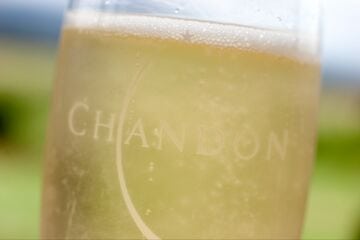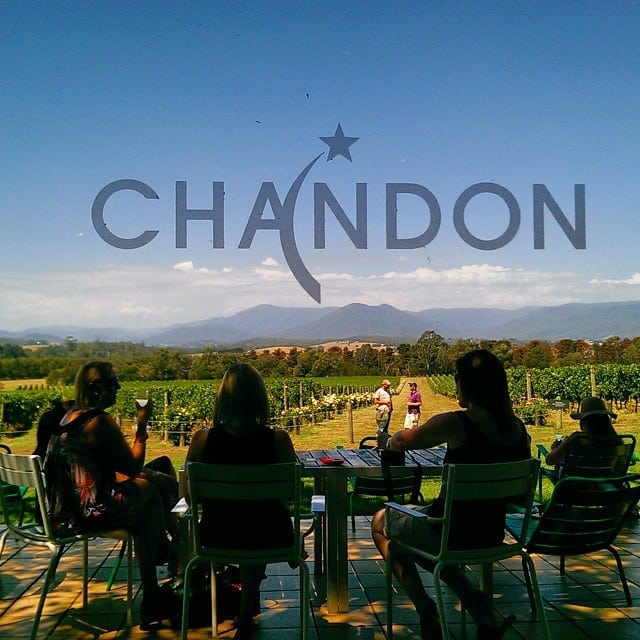“Come quickly, I’m tasting stars!” cried the Benedictine monk Dom Perignon when he tasted the first results of his novel winemaking technique. Contrary to popular belief, though, Dom Perignon was not the inventor of champagne, but as cellar master at the Benedictine abbey in Hautvillers he did make important advances in its production. And his famous saying is celebrated by the star-shaped garden that graces the drive at Domaine Chandon.
Domaine Chandon is the highlight of our AWTC day tour, and is a striking contrast with the rustic charm of our last stop, Yering Farm. Where Yering Farm have carefully preserved their cellar door as it was in 1950, Domaine Chandon have fastidiously restored the
farmhouse that they acquired along with the land at Green Point that now forms Domaine Chandon. The winery is the result of a bold marketing decision by French champagne makers Moet et Chandon. They had already set up joint ventures in South America and California, and the Yarra Valley’s climate and soil characteristics argued strongly for it to be next on their list. In the mid-80s they acquired Green Valley, a dairy farm. It turned out to be a champagne-maker’s dream, and they began transforming the property into the powerhouse it is today, making Moet & Chandon, Dom Perignon, Krug, Ruinart and Veuve Cliquot champagnes.
 To the farmhouse have been added acres of champagne-making equipment, elegant dining facilities, tasting bar and a shop that sells all manner of gourmet goodies. But first things first; we’re there to learn. Spud, our trusty driver and emergency wine tasting tutor, gave us a succinct introduction to methode champenoise.
To the farmhouse have been added acres of champagne-making equipment, elegant dining facilities, tasting bar and a shop that sells all manner of gourmet goodies. But first things first; we’re there to learn. Spud, our trusty driver and emergency wine tasting tutor, gave us a succinct introduction to methode champenoise.
Oddly enough – to the novice – champagne is typically made from pinot grapes. Because the skins are discarded the colour is lost. The essence of the method is the second fermentation. Once the first fermentation is complete, a small dose of sugar and yeast is added to the bottle, and it is restopped with a pressure cap. The secondary fermentation takes place over a matter of years. During this time a quantity of sediment, known to the winemaker as lees, accumulates at the bottom of the bottle. A manual process known as riddling is used to move the lees to the neck of the bottle. At this point the neck of the bottle is frozen and the cap removed, whereupon the frozen plug, bearing the unwanted sediment, is ejected by the pressure that has built up over the course of the second fermentation. Quickly, so that most of the carbon dioxide remains in the champagne, the final cork is inserted.
 We learned all this while touring the Domaine Chandon winemaking sheds, impressive structures full of stainless steel plant that looked eminently capable of performing the wondrous deeds that bring Dom Perignon’s stars to life, and which Spud explained with the clarity of an expert.
We learned all this while touring the Domaine Chandon winemaking sheds, impressive structures full of stainless steel plant that looked eminently capable of performing the wondrous deeds that bring Dom Perignon’s stars to life, and which Spud explained with the clarity of an expert.
Time to taste those stars, and the air of Gallic sophistication was reinforced as we were taken to the tasting bar and given a palate tour by Domaine Chandon’s own guide. The tasting bar is adjacent to the Domaine’s kitchens, and our champagnes were accompanied by some of the most delicious amuses bouches your correspondent has ever tasted.
The dome-shaped roof of traditional wine-makers’ buildings has been used as an architectural motif for Domaine Chandon, and gives it its crowning glory – the vast picture window that looks out over the vines from the dining hall.
And with a glass in one hand, and another intriguing nibble in another, that’s the view we take in as we enjoy the unique ambience of this astonishing winemaker.